USS Agamenticus was one of four Miantonomoh-class monitors built for the United States Navy during the American Civil War. Commissioned as the war was ending in May 1865, the ironclad saw no combat and was decommissioned in September and placed in reserve. The ship was reactivated in 1870, having been renamed Terror the previous year, and was assigned to the North Atlantic Fleet where she served in the Caribbean Sea. The monitor was decommissioned again in 1872 and was sold for scrap two years later. The Navy Department evaded the Congressional refusal to order new ships by claiming that the Civil War-era ship was being repaired while building a new monitor of the same name.

USS Galena was a wooden-hulled broadside ironclad built for the United States Navy during the American Civil War. The ship was initially assigned to the North Atlantic Blockading Squadron and supported Union forces during the Peninsula Campaign in 1862. She was damaged during the Battle of Drewry's Bluff because her armor was too thin to prevent Confederate shots from penetrating. Widely regarded as a failure, Galena was reconstructed without most of her armor in 1863 and transferred to the West Gulf Blockading Squadron in 1864. The ship participated in the Battle of Mobile Bay and the subsequent Siege of Fort Morgan in August. She was briefly transferred to the East Gulf Blockading Squadron in September before she was sent to Philadelphia, Pennsylvania for repairs in November.

Kōtetsu, later renamed Azuma, was the first ironclad warship of the Imperial Japanese Navy. She was designed as an armored ram for service in shallow waters, but also carried three guns. The ship was built in Bordeaux, France, for the Confederate States Navy under the cover name Sphinx, but was sold to Denmark after the sale of warships by French builders to the Confederacy was forbidden in 1863. The Danes refused to accept the ship and sold her to the Confederates which commissioned her as CSS Stonewall in 1865. The ship did not reach Confederate waters before the end of the American Civil War in April and was turned over to the United States.
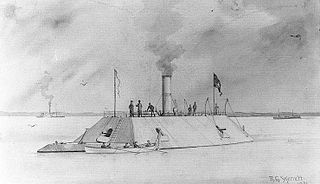
CSS Palmetto State was one of six Richmond class casemate ironclad rams built for the Confederate States Navy during the American Civil War. Completed in 1862, she defended Charleston, South Carolina and was burnt in 1865 to prevent her capture by advancing Union troops.

USS Canonicus was a single-turret monitor built for the United States Navy during the American Civil War, the lead ship of her class. The ship spent most of her first year in service stationed up the James River, where she could support operations against Richmond and defend against a sortie by the Confederate ironclads of the James River Squadron. She engaged Confederate artillery batteries during the year and later participated in both attacks on Fort Fisher, defending the approaches to Wilmington, North Carolina, from December 1864 to January 1865.
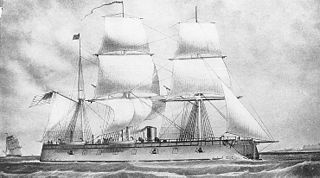
USS New Ironsides was a wooden-hulled broadside ironclad built for the United States Navy during the American Civil War. The ship spent most of her career blockading the Confederate ports of Charleston, South Carolina, and Wilmington, North Carolina, in 1863–65. New Ironsides bombarded the fortifications defending Charleston in 1863 during the First and Second Battles of Charleston Harbor. At the end of 1864 and the beginning of 1865 she bombarded the defenses of Wilmington in the First and Second Battles of Fort Fisher.
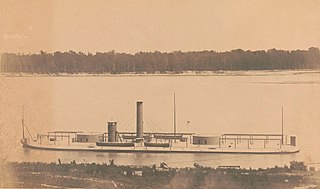
USS Chickasaw was an ironclad Milwaukee-class river monitor built for the United States Navy during the American Civil War. The ship participated in the Battle of Mobile Bay in August 1864, during which she was lightly damaged, and the bombardments of Forts Gaines and Morgan as Union troops besieged the fortifications defending the bay. In March–April 1865, Chickasaw again supported Union forces during the Mobile Campaign as they attacked Confederate fortifications defending the city of Mobile, Alabama.
The first USS Miantonomoh was the lead ship of her class of four ironclad monitors built for the United States Navy during the American Civil War. Completed after the war ended in May 1865, the ship made one cruise off the East Coast before she began a voyage across the North Atlantic in May 1866 to conduct a lengthy showing the flag mission in Europe. Miantonomoh was decommissioned upon her return in 1867, but was reactivated two years later and assigned to the North Atlantic Squadron before decommissioning again in 1870. The monitor was sold for scrap three years later as part of a scheme where the Navy Department evaded the Congressional refusal to order new ships by claiming that the Civil War-era ship was being repaired while building a new monitor of the same name.
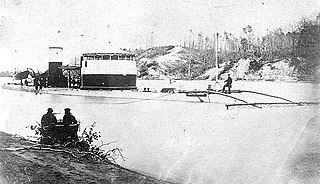
USS Saugus was a single-turreted Canonicus-class monitor built for the Union Navy during the American Civil War. The vessel was assigned to the James River Flotilla of the North Atlantic Blockading Squadron upon completion in April 1864. The ship spent most of her time stationed up the James River where she could support operations against Richmond and defend against a sortie by the Confederate ironclads of the James River Squadron. She engaged Confederate artillery batteries during the year and later participated in both attacks on Fort Fisher, defending the approaches to Wilmington, North Carolina, in December 1864 – January 1865. Saugus returned to the James River after the capture of Fort Fisher and remained there until Richmond, Virginia, was occupied in early April.
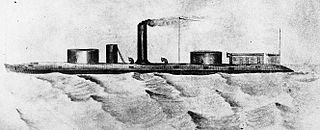
USS Winnebago was a double-turret Milwaukee-class river monitor, named for the Winnebago tribe of Siouan Indians, built for the Union Navy during the American Civil War. The ship participated in the Battle of Mobile Bay in 1864, during which she was lightly damaged, and the bombardments of Forts Gaines and Morgan as Union troops besieged the fortifications defending the bay. In early 1865, Winnebago again supported Union forces during the Mobile Campaign as they attacked Confederate fortifications defending the city of Mobile, Alabama. She was placed in reserve after the end of the war and sold in 1874.
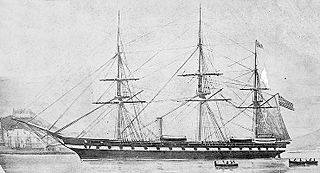
USS Roanoke was a wooden-hulled Merrimack-class screw frigate built for the United States Navy in the mid-1850s. She served as flagship of the Home Squadron in the late 1850s and captured several Confederate ships after the start of the American Civil War in 1861. The ship was converted into an ironclad monitor during 1862–63; the first ship with more than two gun turrets in history. Her conversion was not very successful as she rolled excessively and the weight of her armor and turrets strained her hull. Her deep draft meant that she could not operate off shallow Confederate ports and she was relegated to harbor defense at Hampton Roads, Virginia for the duration of the war. Roanoke was placed in reserve after the war and sold for scrap in 1883.

USS Osage was a single-turreted Neosho-class monitor built for the Union Navy during the American Civil War. After completion in mid-1863 by Edward Hartt, the ship patrolled the Mississippi River against Confederate raids and ambushes as part of Rear Admiral David Porter's Mississippi Squadron. Osage participated in the Red River Campaign in March–May 1864, during which she supported the capture of Fort DeRussy in March and participated in the Battle of Blair's Landing in April. The ship was grounded on a sandbar for six months after the end of the campaign and badly damaged. Osage, after being refloated and repaired, was transferred to the West Gulf Blockading Squadron in early 1865 for the campaign against Mobile, Alabama. During the Battle of Spanish Fort in March 1865 she struck a mine and rapidly sank. The ship was later salvaged and sold in 1867.
USS Kickapoo was a double-turreted Milwaukee-class river monitor, the lead ship of her class, built for the Union Navy during the American Civil War. The ship supported Union forces during the Mobile Campaign as they attacked Confederate fortifications defending the city of Mobile, Alabama in early 1865. She was placed in reserve after the end of the war and sold in 1874.
The first USS Milwaukee, a double-turreted Milwaukee-class river monitor, the lead ship of her class, built for the Union Navy during the American Civil War. The ship supported Union forces during the Mobile Campaign as they attacked Confederate fortifications defending the city of Mobile, Alabama in early 1865. She struck a mine in March and sank without loss. Her wreck was raised in 1868 and broken up for scrap that was used in the construction of a bridge in St. Louis, Missouri.

USS Tonawanda was one of four Miantonomoh-class monitors built for the United States Navy during the American Civil War of 1861–1865. Commissioned in 1865 after the war ended in May, the ship was decommissioned at the end of the year, but was reactivated to serve as a training ship at the United States Naval Academy in 1866. She was renamed Amphitrite in 1869 and was decommissioned again in 1872. The monitor was sold for scrap the following year. The Navy Department evaded the Congressional refusal to order new ships by claiming that the Civil War-era ship was being repaired while building a new monitor of the same name.

USS Manhattan was a single-turreted Canonicus-class monitor built for the Union Navy during the American Civil War. After commissioning in 1864 the ship was assigned to the West Gulf Blockading Squadron and participated in the Battle of Mobile Bay. At the end of the battle, Manhattan took the surrender of the Confederate casemate ironclad ram Tennessee. She bombarded Fort Morgan during the Siege of Fort Morgan and later blockaded the mouth of the Red River until the end of the war.

USS Mahopac (1864) was a Canonicus-class monitor built for the Union Navy during the American Civil War. The vessel was assigned to the James River Flotilla of the North Atlantic Blockading Squadron upon completion in September 1864. The ship spent most of her time stationed up the James River where she could support operations against Richmond and defend against sorties by the Confederate ironclads of the James River Squadron. She engaged Confederate artillery batteries during the year and later participated in both the first and second battles of Fort Fisher, defending the approaches to Wilmington, North Carolina, in December 1864 – January 1865. Mahopac returned to the James River after the capture of Fort Fisher and remained there until Richmond, Virginia was occupied in early April.
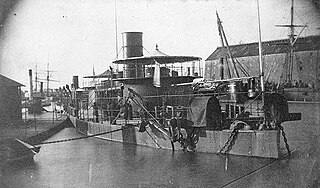
The Miantonomoh class consisted of four monitors built for the Union Navy during the U.S. Civil War, but only one ship was completed early enough to participate in the war. They were broken up in 1874–1875.

The Neosho-class monitors were a pair of ironclad river monitors laid down in mid-1862 for the United States Navy during the American Civil War. After completion in mid-1863, both ships spent time patrolling the Mississippi River against Confederate raids and ambushes as part of Rear Admiral David Porter's Mississippi Squadron. Both ships participated in the Red River Campaign in March–May 1864, although Osage supported the capture of Fort DeRussy in March and participated in the Battle of Blair's Landing in April. Osage was grounded on a sandbar for six months after the end of the campaign while Neosho resumed her patrols on the Mississippi. The latter ship supported the Union Army's operations on the Cumberland River and provided fire support during the Battle of Nashville in December.
The Milwaukee-class monitors were a class of four riverine ironclad monitors built during the American Civil War. Several supported Union forces along the Mississippi River in mid-1864 before participating in the Battle of Mobile Bay in August. Chickasaw and Winnebago bombarded Confederate coastal fortifications during the battle and during subsequent operations as well as engaging the ironclad Tennessee II. The other two ships arrived at Mobile Bay after the battle and all four supported the land attacks on Mobile in March–April 1865. Milwaukee struck a torpedo during this time and sank. The surviving three ships were sold in 1874; Chickasaw was converted into a ferry and survived until 1944 when she was scuttled. Her wreck was discovered in 2004.


















